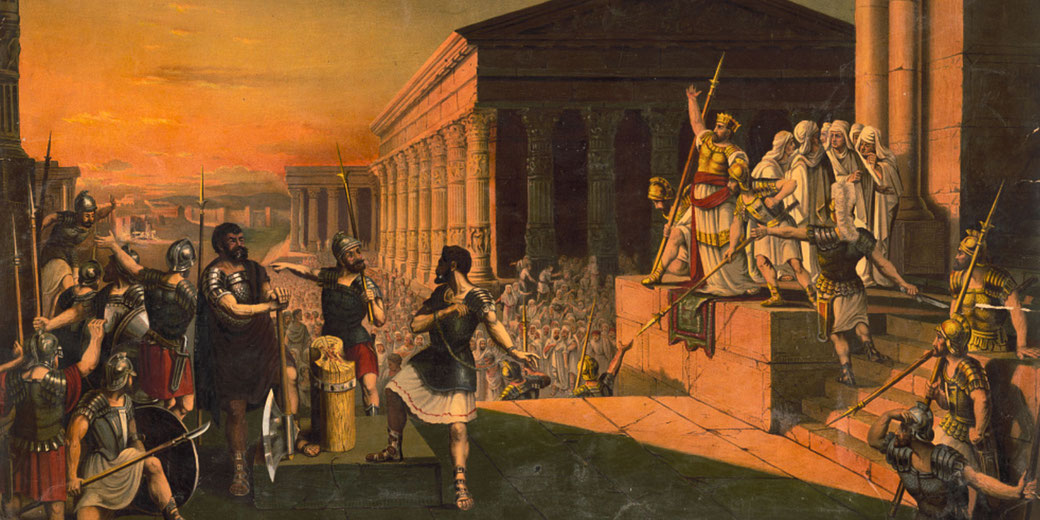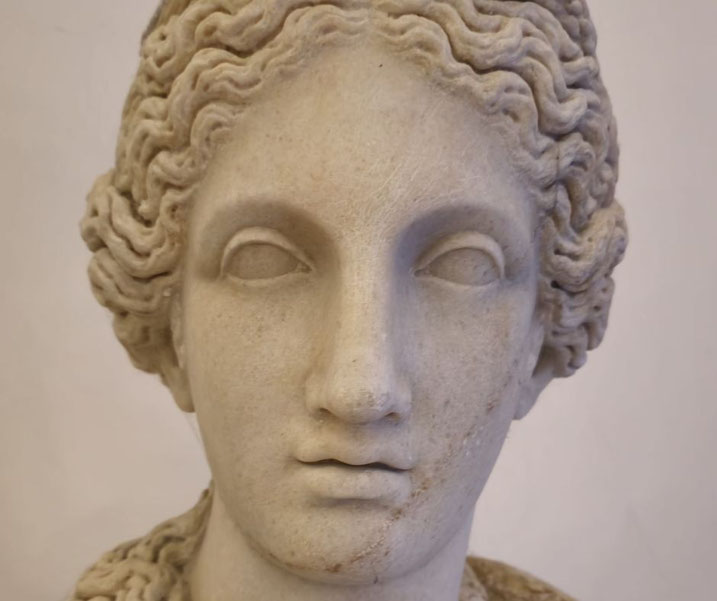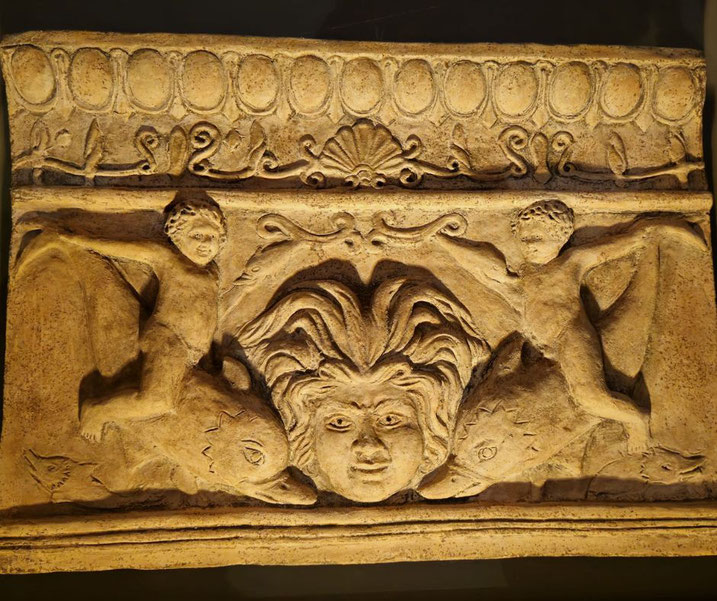9 of the strangest laws and punishments in Ancient Rome

In the grand tapestry of human history, few civilizations have left as indelible a mark as the Roman Empire. From its architectural marvels to its military might, Rome's influence is etched into the bedrock of Western civilization.
Yet, beneath the grandeur and glory lies a labyrinth of peculiarities that often escape the pages of history books. Among these are the Roman Empire's legal oddities—strange laws and punishments that boggle the modern mind.
Why was wearing purple a legal offense for some Romans?
Why were certain foods outlawed?
And how did a criminal end up fighting for their life in the gladiatorial arena?
Some of the craziest laws
Don’t even think about staying single...
In the heart of Rome's golden age, under the reign of the mighty Emperor Augustus, a peculiar law known as the Lex Papia Poppaea was born.
Enacted in 9 AD, this law bore the names of two Roman consuls, Marcus Papius Mutilus and Quintus Poppaeus Secundus, though they were not its true architects.
This legislation was a cornerstone of Augustus' moral reforms, the "leges Juliae et Papiae," designed to boost birth rates among Rome's elite and foster traditional family values.
The Lex Julia law imposed penalties on people of high rank who chose to remain unmarried or who married freed persons.
The Lex Papia Poppaea extended these penalties to all classes of Roman citizens and also offered certain privileges to those who had multiple children, a policy known as "ius trium liberorum."
These privileges included exemptions from certain laws and financial incentives.
Intriguingly, the Lex Papia Poppaea cast a shadow even over the Vestal Virgins, priestesses of Vesta, the goddess of the hearth.
Bound by a 30-year vow of chastity, these women found themselves technically in violation of the law for their refusal to marry and bear children.

Despite its noble intentions, the law was met with resistance and evasion. It was a frequent target of contemporary critics.
The renowned Roman poet Juvenal lampooned the law in his verses, while the historian Tacitus pointed out its failure to boost the birth rate among the upper classes, as intended.
The Lex Papia Poppaea persisted until its eventual abolition in the 5th century AD.
Regardless of its controversial nature and unpopularity, it stands as a testament to the Roman state's efforts to shape personal behavior for what was perceived as the greater good of society.
Be careful what you wear...
Two centuries before Augustus, a unique set of laws known as 'sumptuary laws' emerged, casting a watchful eye over personal extravagance.
They regulated personal expenditure, particularly on items of luxury and ostentation, such as clothing, food, and personal adornments.
The primary purpose of these laws was to control conspicuous consumption and to maintain the social hierarchy by ensuring that certain goods and displays of wealth were reserved for specific social classes.
One of the earliest known Roman sumptuary laws was the Lex Oppia, enacted in 215 BC during the Second Punic War.
This law limited the amount of gold women could possess, restricted the extravagance of women's clothing, and even regulated the use of chariots.
The law was repealed around two decades later, but not without significant opposition from conservative elements of Roman society.
Another well-known sumptuary law was the Lex Fannia, passed in 161 BC, which placed restrictions on the lavishness of banquets, including the number of guests that could be invited and the types of dishes that could be served.

Perhaps the most famous sumptuary law was also part of the Lex Julia, enacted by Julius Caesar and later reinforced by Augustus.
This law regulated the wearing of the toga, a garment that was a symbol of Roman citizenship.
The law stipulated that only the Emperor could wear a completely purple toga, a color associated with royalty and power.
This was a clear visual representation of the social hierarchy and the special status of the Emperor.
While the sumptuary laws were intended to maintain social order and prevent excessive spending, they were often criticized and evaded.
They were also difficult to enforce, and over time, they were largely ignored or abolished.
If you DON'T fart, you’re in trouble...
The so-called "Fart Law" is a somewhat humorous and peculiar aspect of Roman history.
According to the Roman historian Suetonius, in his work "The Twelve Caesars," Emperor Claudius (10 BC – 54 AD) once expressed a desire to pass a law allowing people to pass gas at mealtimes.
Claudius was reportedly concerned about the health implications of retaining wind. He believed that holding it in could be bad for the digestive system and potentially even fatal.
Therefore, he supposedly considered legalizing the act of farting at meals to promote better health.

However, it's important to note that there's no evidence that such a law was ever formally enacted or enforced.
Suetonius, writing nearly a century after Claudius's death, is our only source for this anecdote, and he is known for including scandalous and humorous stories in his works.
As such, the "Fart Law" is more likely a piece of historical humor rather than a serious piece of legislation.
Regardless, the story has endured as a popular anecdote in discussions of Roman law and culture, illustrating both the eccentricities of Emperor Claudius and the broader Roman concern with health and digestion.
If you’re going to steal, be very good at it...
There was once a peculiar concept known as the 'usucapion', which was a principle in Roman law that allowed for the acquisition of ownership over a thing through possession over a certain period.
This was similar to the modern legal principle of adverse possession, where a person can gain ownership of a property if they possess it openly and continuously for a certain period, and the original owner does not contest it.
In Roman law, the period required for usucapio varied depending on the type of property and the circumstances.
For movable property, the period was generally one year, while for immovable property like land, it was two years. However, these periods could be longer in certain situations.
The principle of usucapio was based on the idea that if the original owner did not care enough about the property to notice and contest the possession, they did not deserve to keep it.
It also served a practical purpose by helping to resolve disputes and clarify ownership in a time when there were no comprehensive public records of property ownership.
However, usucapio could not be used to legitimize possession of stolen goods or goods obtained through violence or fraud.
The possessor had to have obtained the property in good faith, believing that it was rightfully theirs.
If the original owner could prove that the property was stolen or obtained unlawfully, they could reclaim it, regardless of how long the possessor had held it.
The unimaginably cruel punishments
‘Getting the sack’ was much worse in Rome...
The "poena cullei" — or "penalty of the sack" — was a unique and particularly gruesome form of capital punishment used in ancient Rome for the crime of parricide, which is the act of killing one's father, mother, or other close relative.
The details of the punishment vary somewhat in different historical accounts, but the most commonly described method is as follows: The condemned person was first scourged (whipped), then sewn into a large leather sack, along with an assortment of live animals.
The animals typically included a dog, a rooster, a snake, and a monkey, each symbolizing a different aspect of the heinous crime.
The sack was then sealed and thrown into a river, lake, or the sea, effectively drowning the condemned person and the animals inside.
The poena cullei was more than just a method of execution; it was a form of symbolic retribution.
The inclusion of the animals, each one representing a different aspect of the crime, was meant to reflect the chaos and unnaturalness of the act of parricide.
The sack itself symbolized the womb, and the act of throwing it into the water was seen as a form of reverse birth, effectively erasing the offender from existence.
This punishment was rarely used, due to the infrequency of the crime of parricide and the complexity of the ritual.
No water (nor fire) for you!
"Maiestas" was a term in Roman law that referred to crimes against the majesty of the Roman people, similar to what we might today call treason.
The concept of maiestas was broad and could encompass a range of offenses, from plotting against the state to degrading its honor and dignity.
The most serious form of maiestas was "laesa maiestas" or "injured majesty," which involved direct acts against the Roman Emperor.
The punishment for maiestas could be severe. One such punishment was "aquae et ignis interdictio," which translates to "interdiction from water and fire."
This was a form of banishment in which the convicted person was forbidden to use or be near fire and water, which were considered the basic elements of life.
In practical terms, it meant that the person was exiled and could not live within the borders of the Roman Empire.
This punishment effectively stripped the person of their Roman citizenship and all the rights and protections that came with it.
They were considered an outcast and were left to fend for themselves in foreign lands.
This was a severe punishment in a society where citizenship was highly valued and offered significant legal and social advantages.
It's worth noting that the application of the law of maiestas and the punishment of aquae et ignis interdictio varied over time and were often influenced by political factors.
During periods of political instability or autocracy, accusations of maiestas were sometimes used as a tool to eliminate political rivals or suppress dissent.
Don't get sent to Spain...
On of the most feared punishments was known as "Damnatio ad metallum," which translates to "condemnation to the mines," was a form of punishment in the Roman Empire typically reserved for slaves, prisoners of war, and serious criminals.
This punishment was considered one of the harshest and most brutal forms of forced labor in the Roman penal system.
Those sentenced to damnatio ad metallum were sent to work in the mines across the Roman Empire, from Britain to Spain to North Africa.
The conditions in these mines were notoriously harsh. Workers were often shackled to prevent escape and were forced to work long hours in dangerous and unhealthy conditions.
Many of the mines were underground, where workers had to contend with darkness, poor ventilation, and the risk of cave-ins.
Above-ground mines were not much better, with workers exposed to the elements and the hazards of quarrying stone or other materials.
The work was physically demanding and often involved digging, hauling heavy loads, and processing the mined materials.
Safety measures were virtually nonexistent, and injuries were common. The combination of hard labor, poor nutrition, and harsh conditions meant that many of those condemned to the mines did not survive for long.
Damnatio ad metallum was not just a punishment but also a form of economic exploitation.
The mines were a vital source of wealth for the Roman Empire, producing precious metals like gold and silver, as well as other valuable resources like lead, iron, and marble.
The use of forced labor allowed the Romans to extract these resources at minimal cost.
Being 'sent to the animals'...
"Damnatio ad bestias," which translates to "condemnation to beasts," was a form of capital punishment in the Roman Empire where condemned criminals were killed by wild animals.
This punishment was typically carried out in the amphitheater as part of the "ludi meridiani" (midday games) that took place between the morning and afternoon gladiatorial contests.
The spectacle was designed not only as a form of execution but also as a form of public entertainment.
The condemned were often defenseless and were sometimes tied to posts or released into the arena before the animals were let loose. The types of animals used varied but could include lions, leopards, bears, and bulls.
Damnatio ad bestias was typically reserved for the lowest members of society, such as slaves, disgraced soldiers, and Christians.
It was considered a particularly shameful form of death, as it not only involved a painful and terrifying end but also denied the person a proper burial, which was of great importance in Roman culture.
The practice was part of the broader Roman tradition of spectacles of death, which served both to entertain the populace and to reinforce the power of the state.
It was also a demonstration of Rome's wealth and power, as the procurement and transport of exotic animals from across the empire was a costly and logistically complex endeavor.
The practice of damnatio ad bestias continued into the early Christian era but began to decline as the Roman Empire became increasingly Christianized.
It was eventually abolished, along with gladiatorial games, in the late 5th century AD.
Be prepared to fight for your life...
Similar to the previous punishment, "Damnatio ad ludum gladiatorium," which translates to "condemnation to the gladiatorial games," was a form of capital punishment in the Roman Empire where criminals were forced to become gladiators and fight to the death in the arena.
This punishment was typically reserved for slaves, prisoners of war, and serious criminals.
Those sentenced to damnatio ad ludum gladiatorium were sent to a "ludus," a gladiatorial training school, where they were taught the skills necessary for arena combat.
They were then forced to fight in the gladiatorial games, often against other condemned criminals, professional gladiators, or wild animals.
The gladiatorial games were a popular form of public entertainment in Rome, and the spectacle of combat to the death was seen as a demonstration of Roman martial virtue.
However, for those condemned to the games, it was a brutal and often short-lived existence. While some gladiators could earn fame and fortune, most were simply fighting for survival.
The practice of damnatio ad ludum gladiatorium was part of the broader Roman tradition of spectacles of death, which served both to entertain the populace and to reinforce the power of the state.
It was also a form of social control, as it provided a stark warning of the consequences of breaking the law.
What do you need help with?
Download ready-to-use digital learning resources
Copyright © History Skills 2014-2025.
Contact via email
With the exception of links to external sites, some historical sources and extracts from specific publications, all content on this website is copyrighted by History Skills. This content may not be copied, republished or redistributed without written permission from the website creator. Please use the Contact page to obtain relevant permission.





